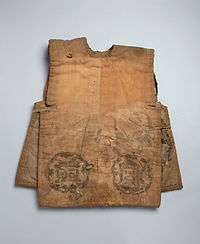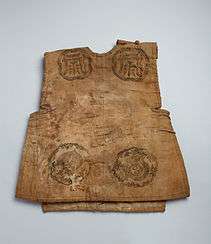Myeonje baegab
Myeonje baegab (면제배갑, 綿製背甲) was a soft bulletproof vest invented in 1867 in the Joseon dynasty.[1][2]


| Myeonje baegab | |
| Hangul | 면제배갑 |
|---|---|
| Hanja | 綿製背甲 |
| Revised Romanization | Myeonje Baegap |
| McCune–Reischauer | Myŏnje Paegap |
It was invented following the French Campaign against Korea, 1866 and used in battle during the United States expedition to Korea in 1871. It was made of between 13 and 30 folds of cotton fabric and covered the upper torso.
Background
During the French Campaign against Korea, 1866, the military of the Joseon Kingdom, at the time using matchlock muskets, experienced the superiority of Western rifles. As a result, Heungseon Daewongun, then acting leader of the Joseon Kingdom, ordered the development of bullet-proof armor.
The vests were distributed to soldiers after its creation, and were used in battles fought on Ganghwa Island against United States Navy and Marine forces during the United States expedition to Korea in 1871.
The US army captured one of the vests and took it to the US. The vest was stored in the Smithsonian Museum until 2007. The vest has since been sent back to Korea and is currently on display to the public.[3]
Notes
- "면제갑옷". 문화재청 (in Korean). Cultural Heritage Administration. Retrieved 27 March 2017.
- "세계최초의 방탄조끼 조선군의 '면제배갑'". 한겨레 (in Korean). 21 February 2007. Retrieved 27 March 2017.
- "Seoul Yonhap News Agency, 1 April 2008". Archived from the original on 13 February 2012. Retrieved 3 June 2008.